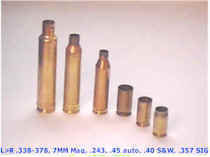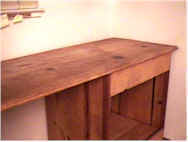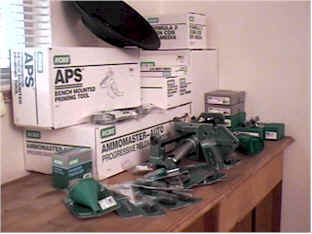I know that reloading has been covered many times, by many people, with far greater expertise. What I would like to do, is cover the subject more as a person working through the process for the first time, rather than an expert with all of the answers. If I could accomplish anything, it would be to let others see this is a straightforward and enjoyable activity, rather than something to fear, or one that is overly complex.

 Why am I attempting to reload ? Two primary reasons. First, I want to save some money. Over the years I have accumulated a number of guns, and I now spend more time at the range. Center fire rifle and pistol ammo runs in price from moderate, to “Jeez, you’re kidding me !”. I know I can’t save much over a box of .40 S&W Speer Lawman ammo, but I bet I can save a ton over a box of Cor-Bon +P jacketed hollow points for my .357 SIG. I could probably buy equipment to make my own brass, go on safari, and still save money over a box of ammo for my .338-378 Weatherby. Yes the cost is really that bad and, yes, I really do like shooting this gun.
Why am I attempting to reload ? Two primary reasons. First, I want to save some money. Over the years I have accumulated a number of guns, and I now spend more time at the range. Center fire rifle and pistol ammo runs in price from moderate, to “Jeez, you’re kidding me !”. I know I can’t save much over a box of .40 S&W Speer Lawman ammo, but I bet I can save a ton over a box of Cor-Bon +P jacketed hollow points for my .357 SIG. I could probably buy equipment to make my own brass, go on safari, and still save money over a box of ammo for my .338-378 Weatherby. Yes the cost is really that bad and, yes, I really do like shooting this gun.
| Caliber | Type | Qty | Cost New | Cost Reload | Savings |
| .357 SIG | Cor-bon 125 JHP | 50 | $35.00 | $4.50* | $30+ |
| .40 S & W | Cor-bon 135 JHP | 50 | $30.00 | $4.50* | $25+ |
| .338-378 | Wby 250 Gr Nosler | 20 | $85.00 | $9.00** | $76 |
* Does not include cost of brass which may be reused 5 – 20 times. New, unloaded brass is approx. $6/50
** Based on Barnes-X 250 gr bullets. Unloaded .338-378 Weatherby brass is approx. $35/20
The second reason for reloading is an interest in ballistics, and a chance to load ammo to safe, yet higher performance specs, not available in over the counter brands. Some of the newer component level powders and bullets on the market seem to offer substantial performance improvements over factory ammo. Through reloading, I can practice safe experimentation, and log and track my progress toward improved cartridge power and accuracy. Reloading requires discipline in process and documentation.
I began by gathering information, with the objective of defining the potential scope of the project. I read a lot of magazines, asked questions in related newsgroups, communicated with friends, and checked out a bunch of web sites. I also collected manufacturers’ literature and price lists, which proved very helpful when I got to the purchasing part of the program. Retail stores were the least helpful in providing early information, as a basis for initial equipment selection and analyzing costs/benefits.
Many stores carry a limited inventory of reloading materials, and almost all are really biased toward a single brand. So no matter the question, the solution will typically be presented from within the product line they carry, and what the store has in stock. Retail stores frequently will label anything they don’t have in stock as “special order”, and proudly quote 5 years for delivery, at 3X suggested retail price, with the expectation you’ll settle for what they have. Again, in the pursuit of information, retail stores will typically provide the least, and sales pressure you the most.
Manufacturers, on the other hand, are very helpful in explaining their own equipment, as well as equipment manufactured by competitors. And, because few manufactures sell direct to end users, at least not at competitive prices, you can usually get the info without the sales pressure. Manufacturers are typically better equipped to present their solution to a reloading situation, in direct comparison to a competitor’s solution. As an example, one manufacturer may provide an audible alarm when a case is detected with a missing powder charge. Another manufacturer may offer a die with visual references to low or no powder conditions, or offer a die that locks up the press when a missing charge is detected. Rather than dig through a ton of written detail, a manufacturer may outline the systems employed by a group of manufacturers, during the course of a 5 minute phone call. Certainly good enough for preliminary information.
Some companies are committed to mainstream cartridges only, others offer more options and offer a more expansive selection of products and applications to choose from. Some manufacturers seem to make equipment primarily for single stage loading (one step at a time for a batch of ammo), some for progressive reloading (each single round progressing through each step of reloading to completion, with another round immediately following). After thrashing around for awhile, you’ll get a general idea of which company enjoys which reputation. Note – current product is a function of evolution. It’s nice when a manufacturer is first to introduce a feature, but the company that is third in the chain, probably incorporated all of the good points of the earlier designs, without the new product bugs that plagued them.
 After digesting this preliminary information, the thought of reloading still seemed like a good idea. So an investment was made into some reading of commercial reloading manuals. There are some produced by equipment and component suppliers such as RCBS, Hornady, Lee, Dillon, Alliant, Norma, Barnes, Speer etc. Many were available, free, from company web sites. There were also specialized manuals written for reloaders by authors with no association with component suppliers, such as “Wildcat Cartridges” published by Wolfe volumes I & II, or “Handbook for Shooters and Reloaders” volume I & II by P.O. Ackley.
After digesting this preliminary information, the thought of reloading still seemed like a good idea. So an investment was made into some reading of commercial reloading manuals. There are some produced by equipment and component suppliers such as RCBS, Hornady, Lee, Dillon, Alliant, Norma, Barnes, Speer etc. Many were available, free, from company web sites. There were also specialized manuals written for reloaders by authors with no association with component suppliers, such as “Wildcat Cartridges” published by Wolfe volumes I & II, or “Handbook for Shooters and Reloaders” volume I & II by P.O. Ackley.
If reloading really was for me, to what degree ? – light reloading for a cartridge or two, or in the basement volume loading for that special .50 BMG. rifle. Decisions…decisions. After all, with equipment comes a need for space, and space will be proportional to degree of interest and level of activity. Useful space means a dedicated area with: climate control, lighting, electricity, and security. The general consensus is that reloading requires concentration and care, so the area needs to be free of distractions, away from traffic. Components, when not staged for immediate use, need to be locked away.
The difference in cost of a simple lower volume setup, Vs a multi caliber high volume effort is enormous – hundreds of dollars Vs thousands of dollars. Volume is the largest factor in calculating cost, as volume will drive the selection of the type of press and associated accessories. A progressive press, designed for volume, will cost approximately twice the price of a single stage press within the same product line. The difference in price of press accessories may even be considerably more. As an example, a single stage Ammo Master press shell holder from RCBS is about 5 bucks. A shell plate for their Ammo Master Auto press is about $25. A power case trimmer designed to handle volume may carry a suggested retail price of $200, a manual trimmer may be 60% less.
The number of types of cartridges to be reloaded is the other significant factor. Each cartridge will typically require a set of dies, possibly shell holders, maybe additional die plates. Each may also require an investment in a specific type of smokeless powder, bullets, primers, ammo boxes, etc, etc, etc…. You can pick the highest usage rounds now, and add as you develop an interest, or a need. You can convert most good presses from single stage to progressive if the volume demand increases, and you can select from a long list of die sets and associated hardware. Start at the low side, see if you like it, then go on from there.
 I decided I would reload for my .40 and .45 autos because I can burn through a couple of hundred rounds each week. I passed on my old .30/30 because I use less than a box of ammo a year, and it isn’t a very flexible cartridge to reload. I decided to reload for the .338-378 because of ammo cost and lack of a wide variety of factory loads, I passed on my reloading for a .222 Remington Contender because the ammo is cheap and available in many loads. I continued on with the process until I worked my way through all possibilities. The important thing is to be realistic which I, of course, was not. The starting line up is as listed in the photo on the left.
I decided I would reload for my .40 and .45 autos because I can burn through a couple of hundred rounds each week. I passed on my old .30/30 because I use less than a box of ammo a year, and it isn’t a very flexible cartridge to reload. I decided to reload for the .338-378 because of ammo cost and lack of a wide variety of factory loads, I passed on my reloading for a .222 Remington Contender because the ammo is cheap and available in many loads. I continued on with the process until I worked my way through all possibilities. The important thing is to be realistic which I, of course, was not. The starting line up is as listed in the photo on the left.

 Sometimes you need to make changes to accommodate new interests. This pictured, sturdy, yet crude, pine counter space was home to my computer and work equipment. I was forced to quit my job, clear the space for reloading, and move my computer stuff to the outside, unsheltered deck area. I had no choice, I really wanted to reload. My work area, soon filled up with new clutter. I intend to actually open the boxes this weekend, and see if I can make this into a well organized work center.
Sometimes you need to make changes to accommodate new interests. This pictured, sturdy, yet crude, pine counter space was home to my computer and work equipment. I was forced to quit my job, clear the space for reloading, and move my computer stuff to the outside, unsheltered deck area. I had no choice, I really wanted to reload. My work area, soon filled up with new clutter. I intend to actually open the boxes this weekend, and see if I can make this into a well organized work center.
Right now I am waiting for a backlogged set of dies for the .357 SIG and .338-378. I need to actually setup the bench so I can get started with other rounds. In the next installment I’ll cover specifics of selection of a press, some comparisons and why everything is not always as it appears. We’ll call that segment, “How I spent $2.2 million to save a couple hundred bucks, then realized half the expenditures were unnecessary and had to return them to…. “.
More on “How to talk yourself into reloading” – How to talk yourself into reloading Part I How to talk yourself into reloading Part II How to talk yourself into reloading Part III
Thanks
Joe

Email Notification